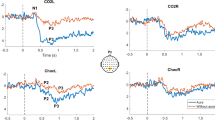Abstract
Objective
To investigate the relative frequency of olfactory aura in a large number of patients with focal epilepsy, and examine the full clinical spectrum of epileptic olfactory auras (OAs) and their relationship to hemispheric lateralization and localization of epileptogenic focus.
Methods
This retrospective study was based on the medical records of 1384 patients with focal epilepsy. Of these, 71 (5.1%) patients were present with OAs, comprising 25 (35.2%) men and 46 (64.8%) women with a mean age of 35.43 ± 12.89 years. These 71 patients were classified according to the clinical features of the OAs, and the electroencephalography and magnetic resonance imaging findings were examined.
Results
The relative frequency of OAs was 5.1% in the focal epileptic patients. The clinical spectrum of OAs in our cases was outlined as follows, complex OAs and elementary OAs. Elementary OAs were divided into three subgroups: elementary neutral OAs, elementary unpleasant OAs, and elementary pleasant OAs. In our cases, there was no difference between the right and left hemispheres in terms of lateralization of the epileptogenic focus. In all the 71 patients, the epileptogenic zone was most commonly localized in the temporal lobe (n = 58; 81.7%).
Conclusions
The relative frequency of OAs in focal epilepsies is likely to be found higher than expected. Elementary OAs occur much more frequently than complex OAs. Among the elementary OAs, elementary unpleasant OAs and elementary neutral OAs are the most common types, whereas elementary pleasant OAs are extremely rare.

Similar content being viewed by others
References
Fisher RS, Cross JH, D’Souza C, French JA, Haut SR, Higurashi N, Hirsch E, Jansen FE, Lagae L, Moshé SL, Peltola J, Roulet Perez E, Scheffer IE, Schulze-Bonhage A, Somerville E, Sperling M, Yacubian EM, Zuberi SM (2017) Instruction manual for the ILAE 2017 operational classification of seizure types. Epilepsia. 58:531–542
Kasper BS, Kasper EM, Pauli E, Stefan H (2010) Phenomenology of hallucinations, illusions and delusious as part of seizure semiology. Epilepsy Behav 18:13–23
Sirven JI, Sperling MR, French JA, O’Connor MJ (1996) Significance of simple partial seizures in temporal lobe epilepsy. Epilepsia 37:450–454
Wieser HG, ILAE Commission on Neurosurgery of Epilepsy (2004) ILAE Commission Report. Mesial temporal lobe epilepsy with hippocampal sclerosis. Epilepsia 45:695–714
Penfield W, Perot P (1963) The brain’s record of auditory and visual experience. A final summary and discussion. Brain 86:595–696
Mulder DW, Daly D (1952) Psychiatric symptoms associated with lesions of temporal lobe. J Am Med Assoc 150:173–176
Chen C, Shih YH, Yen DJ, Lirng JF, Guo YC, Yu HY, Yiu CH (2003) Olfactory auras in patients with temporal lobe epilepsy. Epilepsia 44:257–260
Acharya V, Acharya J, Lüders H (1998) Olfactory epileptic auras. Neurology 51:56–61
Sarnat HB, Flores-Sarnat L (2016) Might the olfactory bulb be an origin of olfactory auras in focal epilepsy? Epileptic Disord 18:344–355
Mills CK (1908) The cerebral centers for taste and smell and the uncinate group of fits, based on the study of a case of a tumor of the temporal lobe with necropsy. JAMA 51:879–885
Dupont S, Samson Y, Nguyen-Michel VH, Zavanone C, Clémenceau S, Miles R, Baulac M, Adam C (2015) Are auras a reliable clinical indicator in medial temporal lobe epilepsy with hippocampal sclerosis? Eur J Neurol 22:1310–1316
Henkin RI, Potolicchio SJ, Levy LM (2013) Olfactory hallucinations without clinical motor activity: a comparison of unirhinal with birhinal phantosmia. Brain Sci 3:1483–1553
Sarnat HB, Flores-Sarnat L, Wei XC (2017) Olfactory development, part 1: function, from fetal perception to adult wine-tasting. J Child Neurol 32:566–578
Hall JE (2016) The chemical senses—taste and smell. Guyton and Hall textbook of medical physiology, 13rd edn. Elsevier Health Sciences, Philadelphia, p 685–692
Author information
Authors and Affiliations
Contributions
I. Tasci MD. Study concept and design; data analysis and interpretation; editing manuscript; accepts responsibility for conduct of research.
F. Balgetir MD. Study concept and design; acquisition of data; data analysis and interpretation; drafting manuscript; accepts responsibility for conduct of research.
B. Mungen MD. Study concept and design; acquisition of data; data analysis and interpretation; drafting manuscript; accepts responsibility for conduct of research.
M. Gonen MD. Data analysis and interpretation; editing manuscript; drafting manuscript; accepts responsibility for conduct of research.
Corresponding author
Ethics declarations
Conflict of interest
The authors declare that they have no conflict of interests.
Ethical approval
This prospective clinical study was approved by the Local Ethic Committee (Approval date, 20.12.2018; No. 21/09). The study was performed in accordance with the principles of Helsinki Declaration.
Informed consent
None.
Code availability
None.
Additional information
Publisher’s note
Springer Nature remains neutral with regard to jurisdictional claims in published maps and institutional affiliations.
Rights and permissions
About this article
Cite this article
Taşcı, İ., Balgetir, F., Müngen, B. et al. Epileptic olfactory auras: a clinical spectrum. Neurol Sci 42, 3397–3401 (2021). https://doi.org/10.1007/s10072-020-04999-x
Received:
Accepted:
Published:
Issue Date:
DOI: https://doi.org/10.1007/s10072-020-04999-x




